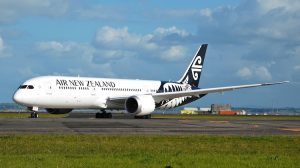
Air New Zealand’s push into the US heartland with new direct flights to Houston is all about opening up more opportunities for those in the US to make the journey across the Pacific, chief executive Christopher Luxon says.
The airline has announced Houston, a Texas oil and gas centre and a major hub of fellow Star Alliance member United, as its fifth North American destination, joining Honolulu, Los Angeles, San Francisco and Vancouver.
Flights will begin in mid-December, with Air NZ to operated refurbished Boeing 777-200ERs, fitted with the airline’s newest on-board products across economy, premium economy and business, on the new route.
Thursday’s announcement continues a period of significant expansion for Air NZ in North America, which now flies up to three times a day to Los Angeles, 10 times a week to San Francisco, daily to Vancouver and five times weekly to Honolulu during peak times.
Moreover, the airline recently began ticket sales for its new Auckland-Buenos Aires flight due to start on December 1.
Research that indicated some 30 million Americans have listed NZ on their “bucket list” of must-visit countries, as well as statistics showing US visitors to NZ have risen 10 per cent over the past year, gave the Kiwi flag carrier the confidence to launch the new route.
“We’ve got really good levels of frequency into North America,” Luxon told Australian Aviation on Thursday.
“We’ve got the depth that we now need, we now want to open up some breadth and this is the next logical leap for us.”
While exact schedules have not been released, the new service when it launches during the summer holidays in December will run five times a week. In the so-called “shoulder” season it will reduce to four times weekly, while there will only be three flights a week during the winter months.
Luxon said the frequency of the route would be subject to demand.
“We are completely flexible,” Luxon said. “If we can build demand in the Americas and also New Zealand and Australasia our ambition is to get to daily services.”
“We are a big believer in that and we’ve done that all across our Asia Pacific gateways now and it has worked very well.”
Luxon said Houston would enable Air NZ to offer those living in US midwest and east coast a quicker alternative to NZ than a long trek across to Los Angeles or San Francisco before a 14-hour flight across the Pacific.
The airline’s marketing in North America has been all about making people understand NZ was much closer than Americans think.
“Some of our research says that an American sitting in the midwest or the east coast can perceive, wrongly, that it takes something like 40 hours to get to New Zealand,” Luxon said.
“By going into Houston, we can now reach out to people in the midwest and east coast and with a one- or two-hour commuter flight to Houston and then a 14-hour flight down to New Zealand, it is a pretty seamless experience.
“If we can make New Zealand more attractive than Croatia and Austria and Thailand and other places that are on the bucket list of Americans, that’s what we want to do.”

Luxon said he expected the directional flows on the route to be very balanced, given the rising number of Kiwis that have been heading to the US in recent years.
And while New Zealand was the main game, Australia was also expected to be a part of that push to support the new route, given Air NZ’s large presence on this side of the Tasman.
“Clearly, it is a seamless transition point through Auckland Airport which is one integrated terminal,” Luxon said.
“So if you are sitting in some parts of Australia it is a very attractive proposition to come through Auckland on the way to South or North America.”
Air NZ has been heavily promoting one-stop connections from Australia to the US via it Auckland hub in recent times, with ticket prices well below $1,000 on selected dates.
United will also codeshare on the Auckland-Houston flights as well as points beyond Auckland. Before its merger with United Continental Airlines had unveiled plans to fly to NZ from Houston in 2010 with 787s, before dropping the idea a year later.
Luxon said Air NZ’s 777-200ER and 777-300ER fleet were the best vehicle for its North American network given the mix of business, premium economy and economy seats on board was ideal for premium leisure customers in the market.
“We know that aircraft and that configuration actually will work very well for us with that mix of customers that we have,” Luxon said.

“The 777-200ER will be perfect for that route from that perspective.”
While the 787-9 fleet had a higher proportion of economy seats and were better suited on routes to Asia, they were fitted with the same seats as the 777s meaning Air NZ could deploy the Dreamliner to North America without changing the product offering.
“They are very similar products in terms of look and feel between those aircraft and it is just about cabin mix,” Luxon said.
“So as the market develops we have total flexibility to flip the aircraft around if we think there are different benefits of running with different configurations into different markets.”
“The 787-9, we’ve got three of them already, we’ve got orders for 12 and may even go higher again depending on how the business performs.”
Currently, the only direct service from Australasia to Texas is with Qantas, which flies six times a week from Sydney to Dallas/Fort Worth with Airbus A380s.
The US is NZ’s third largest source of visitors behind Australia and China.










